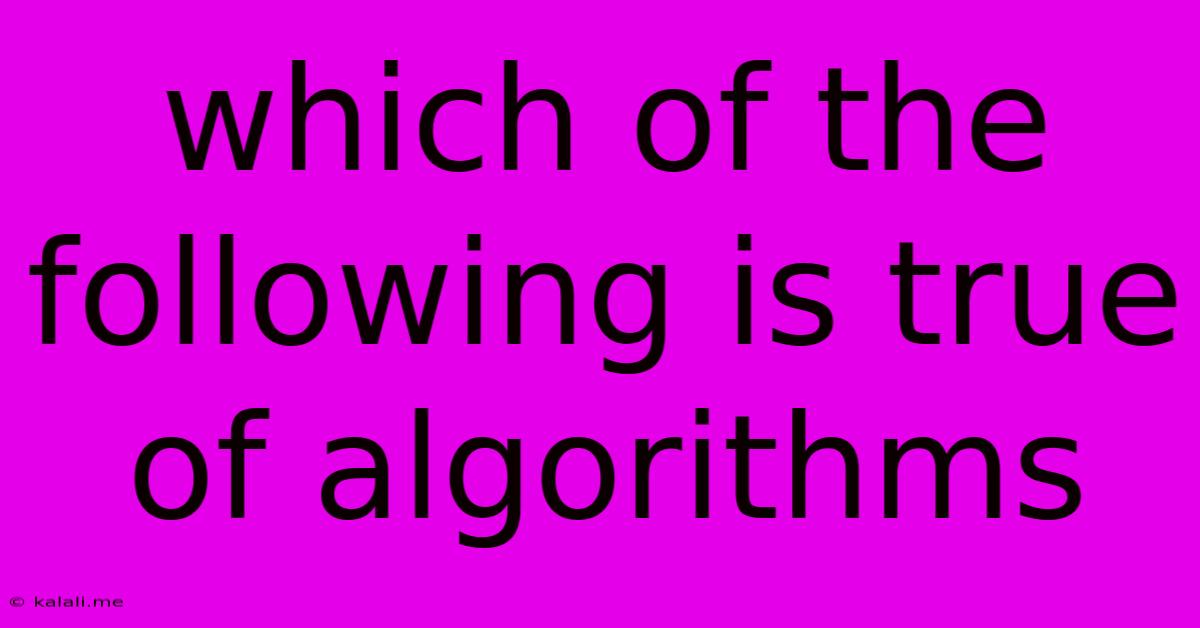Which Of The Following Is True Of Algorithms
Kalali
Jun 11, 2025 · 3 min read

Table of Contents
Which of the Following is True of Algorithms? Decoding the Logic Behind Computation
Algorithms are the backbone of modern computing, silently orchestrating everything from the apps on your phone to the complex calculations powering AI. Understanding what algorithms are and what they do is crucial in today's digital world. This article will explore the core characteristics of algorithms, clarifying common misconceptions and highlighting their essential properties.
What is an Algorithm? An algorithm is a finite sequence of well-defined, computer-implementable instructions, typically to solve a class of problems or to perform a computation. Think of it as a recipe: a step-by-step guide that, when followed precisely, produces a desired outcome. This outcome could be anything from sorting a list of numbers to recommending products based on user preferences.
Key Characteristics of Algorithms: Several key properties define a true algorithm:
- Finiteness: An algorithm must always terminate after a finite number of steps. It can't run indefinitely.
- Definiteness: Each step must be precisely defined; the actions to be carried out must be rigorously and unambiguously specified for each case. No room for ambiguity!
- Input: An algorithm generally takes some input, which can be data, parameters, or initial conditions.
- Output: An algorithm produces an output, which is the result of the computation. This could be a single value, a set of values, or even a transformation of the input data.
- Effectiveness: Each step must be feasible—meaning it can be carried out in practice. The operations shouldn't be theoretically possible but practically impossible to perform.
Common Misconceptions about Algorithms:
- Algorithms are only for computers: While computers are excellent at executing algorithms, the concept of an algorithm predates computers. Many everyday tasks, like baking a cake or following directions, involve algorithmic thinking.
- Algorithms are always efficient: While efficiency is a desirable trait, not all algorithms are equally efficient. Some algorithms may be correct but extremely slow for large inputs. The study of algorithm efficiency is a significant area within computer science. Computational complexity is a key consideration in algorithm design.
- Algorithms are always easy to understand: The inner workings of some algorithms, particularly complex ones used in machine learning or cryptography, can be incredibly intricate and challenging to grasp fully.
Analyzing Statements about Algorithms: Let's consider hypothetical statements about algorithms and determine their truthfulness:
-
Statement 1: "All algorithms require input data." This is generally true. While some very simple algorithms might not explicitly require input (e.g., an algorithm that simply prints "Hello, world!"), most algorithms operate on some form of input to produce meaningful output.
-
Statement 2: "An algorithm can run indefinitely without terminating." This is false. A fundamental property of an algorithm is its finiteness; it must always halt after a finite number of steps. An infinite loop would violate this definition.
-
Statement 3: "Algorithms are only used in computer science." This is false. As mentioned earlier, algorithmic thinking is applicable in various fields, including mathematics, cooking, and even project management.
-
Statement 4: "The efficiency of an algorithm is always constant regardless of input size." This is false. The efficiency of an algorithm often depends on the size of the input data. Some algorithms perform well with small inputs but become incredibly slow with large datasets. This ties directly into the concept of Big O notation, used to classify algorithm efficiency.
In conclusion, understanding the fundamental properties of algorithms is crucial for navigating the digital world. By recognizing the key characteristics – finiteness, definiteness, input, output, and effectiveness – we can critically evaluate statements about algorithms and appreciate their role in shaping our technological landscape. From simple tasks to complex computations, algorithms are the silent workhorses driving innovation and progress.
Latest Posts
Latest Posts
-
Which Of The Following Disasters Has A Slow Onset
Jun 12, 2025
-
Max Moment For Simply Supported Beam
Jun 12, 2025
-
The Motion Of Earth Around The Sun Is Called
Jun 12, 2025
-
A Positive Ion Is Called A
Jun 12, 2025
-
Distinguish Between Direct And Indirect Democracy
Jun 12, 2025
Related Post
Thank you for visiting our website which covers about Which Of The Following Is True Of Algorithms . We hope the information provided has been useful to you. Feel free to contact us if you have any questions or need further assistance. See you next time and don't miss to bookmark.